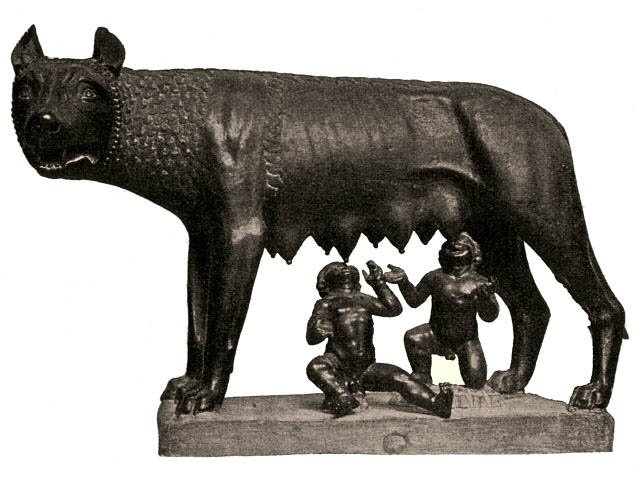Why Is Rome Called ‘The Eternal City’?
Conny Waters - AncientPages.com - Have you ever wondered why Rome became known as the "Eternal City? The city's nickname can be traced to an ancient myth, ancient historical writings, and the old Romans' beliefs in the greatness of their city.
The Capitoline she-wolf with the boys Romulus and Remus. Museo Nuovo in the Palazzo dei Conservatori, Rome. Rome is much older than the myth about Romulus and Remus. Benutzer:Wolpertinger - Public Domain
According to an ancient legend, the city of Rome was founded on April 21, 753 B.C. by Romulus.
Romulus and Remus were twin brothers and sons of the god Mars. Thrown into the river Tiber by a wicked uncle hoping they would drown, the small boys were rescued by a wolf who fed them.
When Romulus and Remus became adults, they decided to establish their city, and each set out to find the best location. They were later discovered and cared for by a shepherd and his wife: Faustulus and Acca Larentia. One day, the two brothers quarreled over where the site should be, and his brother killed Remus.
It left Romulus the sole founder of the new city, and he gave his name to it – Rome. Now, this is just a myth, and the history of Rome goes much further back in time.
According to the legend, Romulus became the first king of Rome in 753 BC. Legends say Numa Pompilius was the second king of Rome, but he was not a warrior king but a statesman and politician.
Nevertheless, archaeologists have discovered artifacts that prove Rome was inhabited much earlier than 753 B.C.
Rome was known as the "Eternal City" because civilizations had lived there for thousands of years. The ancient Roman Empire was mighty, and it had many enemies. Yet, ancient Romans managed to defeat the Carthaginians and Etruscans and extended their empire throughout Europe and Africa. No one underestimated the greatness of the ancient Roman Empire.
Between c. 100 B.C to around 400 A.D, the city of Rome was the largest in the world.
Around 500 A.D., Empire's populace grew to an estimated 50 to 90 million. At the time, this was roughly 20% of the world's population.
Roman writers and poets boasted about their city's greatness. In his epic poem The Aeneid, the poet Virgil wrote the line imperium sine fine – an empire without end.
The first explicit reference to Rome as the Eternal City occurred in the 1st century B.C. Poet Albius Tibullus (55 BC - 19 BC) wrote ‘Romulus aeternae nondum formaverat urbis moenia, consorti non habitanda Remo’ – Tibullus, from Elegies.
In other words, 'not yet had Romulus drawn up the Eternal City's walls, where Remus as co-ruler was fated not to live.
Ancient writers such as Ovid and Livy also took up the expression.
It's no wonder that ancient Romans thought that whatever happened to the rest of the world, Rome would last forever. Rome became known as the "Eternal City."
Rome is called the "Caput Mundi" (Capital of the World). Although the ancient Roman Empire is long gone, we still call it the "Eternal City."
Romulus and Remus were twin brothers and sons of the god Mars. A wicked uncle threw them into the river Tiber, hoping they would drown, but a wolf who fed them rescued them.
They were later discovered and cared for by a shepherd and his wife: Faustulus and Acca Larentia. When Romulus and Remus became adults, they decided to establish their own city, and each set out to find the best location. One day, the two brothers quarreled over where the site should be, and his brother killed Remus.
This left Romulus the sole founder of the new city, and he gave his name to it – Rome. Now, this is just a myth, and the history of Rome goes much further back in time.
According to the legend, Romulus became the first king of Rome in 753 BC. Legends say Numa Pompilius was the second king of Rome, but he was not a warrior king but rather a statesman and politician.
Nevertheless, archaeologists have discovered artifacts showing that Rome was inhabited much earlier than 753 B.C.
Rome was known as the “Eternal City” because civilizations had lived there for thousands of years. The ancient Roman Empire was very powerful and had many enemies. Yet, the ancient Romans managed to defeat the Carthaginians and Etruscans and extend their empire throughout Europe and Africa. No one underestimated the greatness of the ancient Roman Empire.
Between 100 B.C. to around 400 A.D., Rome was the largest city in the world. Around 500 A.D., the Empire's populace grew to an estimated 50 to 90 million inhabitants. At the time, this was roughly 20% of the world's population.
Colosseum at night. Image credit: Ramesh - CC BY-SA 3.0
Roman writers and poets boasted about their city’s greatness. In his epic poem The Aeneid, the poet Virgil wrote the line imperium sine fine – an empire without end.
The first explicit reference to Rome as the Eternal City occurred in the 1st century B.C. Poet Albius Tibullus (55 BC - 19 BC) wrote ‘Romulus aeternae nondum formaverat urbis moenia, consorti non habitanda Remo’ – Tibullus, from Elegies.
In other words, ‘not yet had Romulus drawn up the Eternal City’s walls, where Remus as co-ruler was fated not to live.’
The expression was also taken up by ancient writers such as Ovid and Livy.
It’s no wonder that ancient Romans thought that whatever happened to the rest of the world, Rome would last forever. Rome became known as the “Eternal City”.
Rome is also called the "Caput Mundi" (Capital of the World). The ancient Roman Empire is long gone, but we still call Rome the “Eternal City.”
First version of this article was published on Ancient Pages on April 4, 2018
Written by Conny Waters – AncientPages.com Staff Writer
Copyright © AncientPages.com All rights reserved. This material may not be published, broadcast, rewritten or redistributed in whole or part without the express written permission of AncientPages.com
More From Ancient Pages
-
 Seven New Ancient Buddhist Caves – One With ‘A Harmika’ – Discovered In Mumbai
News | Jan 19, 2016
Seven New Ancient Buddhist Caves – One With ‘A Harmika’ – Discovered In Mumbai
News | Jan 19, 2016 -
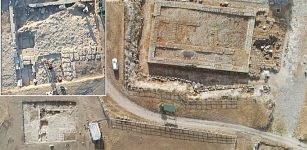 Previously Unknown Monumental Etruscan Temple Found Near The Tempio Grande, Vulci, Latium, Italy
Archaeology | Nov 10, 2022
Previously Unknown Monumental Etruscan Temple Found Near The Tempio Grande, Vulci, Latium, Italy
Archaeology | Nov 10, 2022 -
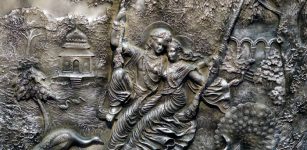 Mysterious Forest Of Treasure – Why Is It Forbidden To Stay In Nidhivan After Sunset?
Featured Stories | Nov 24, 2021
Mysterious Forest Of Treasure – Why Is It Forbidden To Stay In Nidhivan After Sunset?
Featured Stories | Nov 24, 2021 -
 Human Migration Out Of Africa To Middle East Through Corridors Provided By Monsoons
Archaeology | Nov 27, 2019
Human Migration Out Of Africa To Middle East Through Corridors Provided By Monsoons
Archaeology | Nov 27, 2019 -
 DNA From Doggerland That Separates The UK From Europe – New Study
Archaeology | Jul 20, 2020
DNA From Doggerland That Separates The UK From Europe – New Study
Archaeology | Jul 20, 2020 -
 Mystery Of The Lydenburg Heads
Artifacts | Jun 13, 2014
Mystery Of The Lydenburg Heads
Artifacts | Jun 13, 2014 -
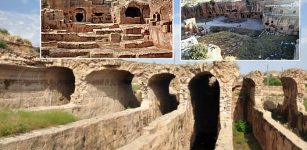 Focus On Unique And Spectacular Gallery Grave In Ancient City Of Dara, Mardin
News | Aug 24, 2020
Focus On Unique And Spectacular Gallery Grave In Ancient City Of Dara, Mardin
News | Aug 24, 2020 -
 Only Apocalyptic Destruction Can Eliminate The Gap Between Rich And Poor – Historian Says
Featured Stories | Jun 6, 2018
Only Apocalyptic Destruction Can Eliminate The Gap Between Rich And Poor – Historian Says
Featured Stories | Jun 6, 2018 -
 Rare Pre-Columbian Archaic Settlement Discovered In The Dominican Republic May Solve A Caribbean Mystery
Archaeology | Apr 12, 2022
Rare Pre-Columbian Archaic Settlement Discovered In The Dominican Republic May Solve A Caribbean Mystery
Archaeology | Apr 12, 2022 -
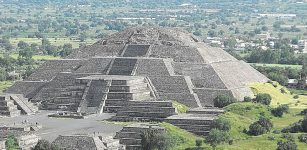 Pyramid Of The Moon At Teotihuacán – Underground Tunnel And Chamber Found
Archaeology | Oct 29, 2018
Pyramid Of The Moon At Teotihuacán – Underground Tunnel And Chamber Found
Archaeology | Oct 29, 2018 -
 Horrifying Flying Head That Terrorized The Iroquois
Featured Stories | Sep 17, 2019
Horrifying Flying Head That Terrorized The Iroquois
Featured Stories | Sep 17, 2019 -
 God Ptah ‘Lord Of Memphis’ Was Among The Most Revered Creator Gods Of Ancient Egypt
Egyptian Mythology | Apr 17, 2018
God Ptah ‘Lord Of Memphis’ Was Among The Most Revered Creator Gods Of Ancient Egypt
Egyptian Mythology | Apr 17, 2018 -
 Seppuku: Ancient Suicide Ritual That Guaranteed Honorable Death Instead For Life In Shame
Ancient Traditions And Customs | Mar 8, 2018
Seppuku: Ancient Suicide Ritual That Guaranteed Honorable Death Instead For Life In Shame
Ancient Traditions And Customs | Mar 8, 2018 -
 Pamola: Mighty Thunderbird In Myths Of Penobscot People Of Maine
Featured Stories | Apr 25, 2019
Pamola: Mighty Thunderbird In Myths Of Penobscot People Of Maine
Featured Stories | Apr 25, 2019 -
 On This Day In History: Battle Of Langside Was Fought – On May 13, 1568
News | May 13, 2016
On This Day In History: Battle Of Langside Was Fought – On May 13, 1568
News | May 13, 2016 -
 Unorthodox Ancient ‘Out-Of-This World’ Carvings Were Found And Destroyed – Mysterious Labyrinth And Unknown Ruins – Part 2
Ancient Mysteries | Aug 13, 2020
Unorthodox Ancient ‘Out-Of-This World’ Carvings Were Found And Destroyed – Mysterious Labyrinth And Unknown Ruins – Part 2
Ancient Mysteries | Aug 13, 2020 -
 Exceptional Discovery Of Ancient Fresco Depicting Mythological Scenes In Peru
Archaeology | Dec 1, 2022
Exceptional Discovery Of Ancient Fresco Depicting Mythological Scenes In Peru
Archaeology | Dec 1, 2022 -
 How Reliable Are Computer ‘Reconstructions’ Of Faces From Ancient Times?
Featured Stories | Sep 3, 2024
How Reliable Are Computer ‘Reconstructions’ Of Faces From Ancient Times?
Featured Stories | Sep 3, 2024 -
 Drone Reveals 3,000-Year-Old ‘Mega Fortress’ Dmanisis Gora In The Caucasus Mountains Is Much Larger Than Previously Thought
Archaeology | Jan 9, 2025
Drone Reveals 3,000-Year-Old ‘Mega Fortress’ Dmanisis Gora In The Caucasus Mountains Is Much Larger Than Previously Thought
Archaeology | Jan 9, 2025 -
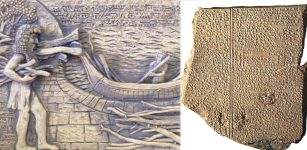 Utnapishtim And The Babylonian Flood Story
Featured Stories | Jan 28, 2016
Utnapishtim And The Babylonian Flood Story
Featured Stories | Jan 28, 2016

